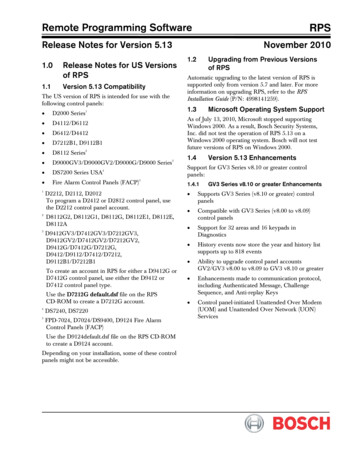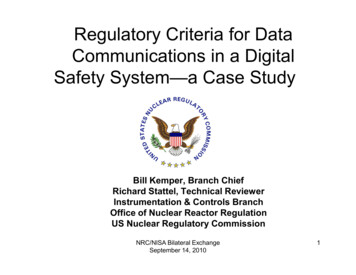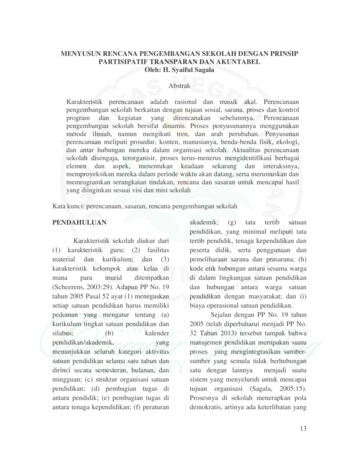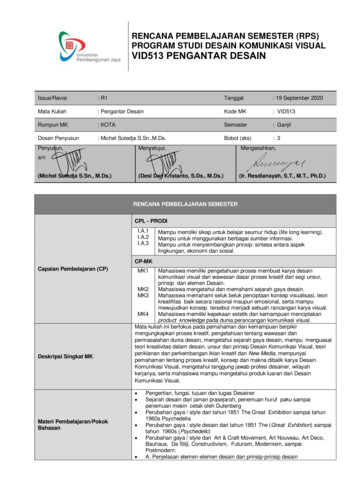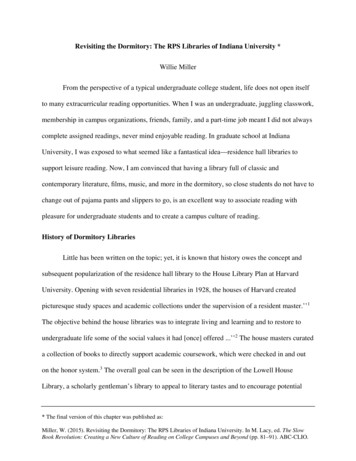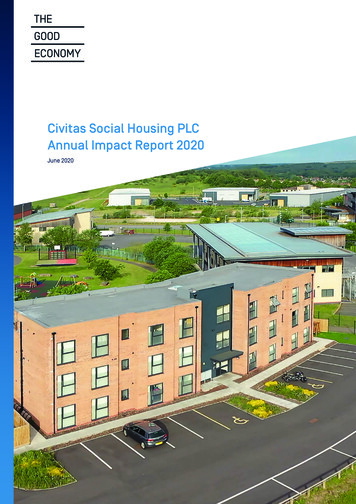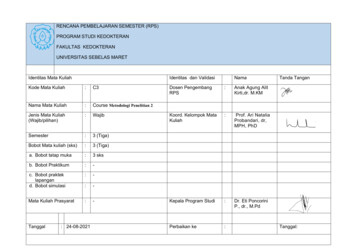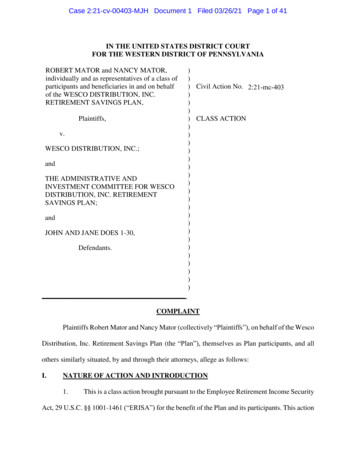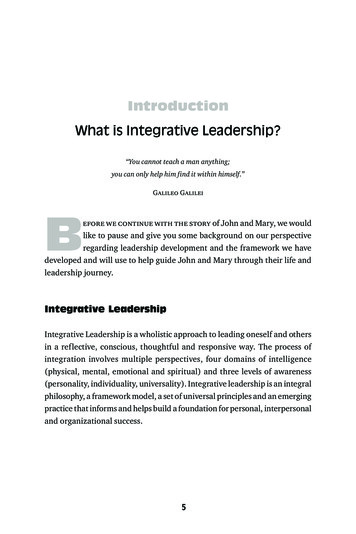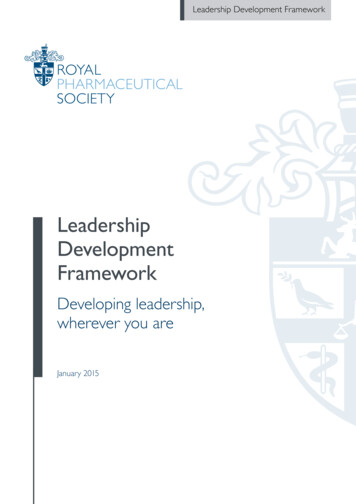
Transcription
Leadership Development FrameworkLeadershipDevelopmentFrameworkDeveloping leadership,wherever you areJanuary 2015
Changes to the structure and culture of healthcare withinthe UK mean there is an increased focus on developingexcellent leadership. This embeds the values of compassionand care in order to improve patient and health outcomes.As a profession, the Royal Pharmaceutical Society (RPS)believes that pharmacists and pharmaceutical scientistsalready make a strong contribution to the delivery ofimproved healthcare, but the time is right to create anew vision of pharmacists as leaders. Current thinking isthat leadership is not reserved for the rare exceptionalperson1: every pre-registration trainee, pharmacist andpharmaceutical scientist in every pharmacy sector hasthe potential to develop leadership attributes andbecome a leader.Building these leadership behaviours can not only aidpersonal and professional development, but also ensurethe unique skills and knowledge of pharmacists andpharmaceutical scientists are optimised to improve theeffectiveness of teams and organisations, quality of workand, ultimately, improve patient care and outcomes.A consistent approach to leadership across the professionis required in order to achieve this. The LeadershipDevelopment Framework (LDF) has been created toprovide uniform development of leadership behavioursfor all pharmacists and pharmaceutical scientists. The LDFoutlines the leadership attributes to which all of the professionshould aspire; it moves the profession beyond leadershipcompetencies (the ‘what to do’ of leadership) into developingengaging leadership behaviours (the ‘how to do’ of leadership)that can help advance the profession. All of which will serveto embed pharmacy as an integral component in the multidisciplinary care of patients, public and other professionals.This LDF mirrors the NHS Leadership Academy’sHealthcare Leadership Model (HLM), currently available foraccess by all staff working in the NHS in England or whocontribute to NHS services2. The LDF extends the reach ofthe HLM into non-NHS pharmacy sectors throughout GreatBritain (GB). Wider research and extensive consultation ofleadership behaviours outside of direct patient-facing rolesensures the HLM, and thus the LDF, is equally applicable forall pharmacists and pharmaceutical scientists, not just thosein patient-facing roles.With the creation of the RPS’ Faculty as a driver for thedevelopment of post-registration professional practiceacross GB, the LDF can also be used when completing theLeadership cluster of the Faculty portfolio. To assist RPSmembers with this, a Handbook and tools for use in practiceare available on the leadership section of the RPS website.Every pharmacist and pharmaceutical scientist in GB is urgedto seize this opportunity to develop their leadership qualitiesfor their own personal progress. In doing so, this can helplead the profession into a new era for improved qualityhealthcare delivery.Take the lead and make a difference so you can becomea better leader tomorrow and a great leader in the future.DR CATHERINE DUGGAN PhD FRPharmSDirector of Professional Development and Suppor tChartered Institute of Personnel and Development. Research Insight. Engaging leadership. Creating organisations that maximise the potential of their people.September 2008. Available at: http://www.cipd.co.uk/binaries/engaging-leadership 2008-updated-01-2010.pdf.2NHS Leadership Academy. Healthcare Leadership Model. The nine dimensions of leadership behaviour. Version 1.0. 2014. Available uploads/dlm ur.pdf.1LEADERSHIP DEVELOPMENT FRAMEWORK2FOREWORDFOREWORD
FOREWORD21.0INTRODUCTION41.1Purpose of the Framework41.2Scope of the Framework41.3Use of the Framework41.4Resources51.5Structure52.0 DEVELOPING LEADERSHIP WHEREVER YOU ARE62.1WHO is the LDF for?62.2WHAT is the LDF?62.3WHY is the LDF needed?62.4WHEN to use the LDF?62.5HOW to use the LDF?72.6HOW is the LDF different from the LCF?72.7WHAT next?72.8Influencing the HLM73.0LDF DOMAINS8Leadership domain 1: Inspiring shared purpose9Leadership domain 2: Leading with care10Leadership domain 3: Evaluating information11Leadership domain 4: Connecting our service12Leadership domain 5: Sharing the vision13Leadership domain 6: Engaging the team14Leadership domain 7: Holding to account15Leadership domain 8: Developing capability16Leadership domain 9: Influencing for results174.018LEADERSHIP DEVELOPMENT ACTION PLANAPPENDIX 1CONTENTSCONTENTS19The Leadership Development Framework was created utilising the NHS Leadership Academy’s Healthcare Leadership Model. NHS Leadership Academy 2014. All rights reserved.LEADERSHIP DEVELOPMENT FRAMEWORK3
1.0 INTRODUCTION1.2 Scope of the FrameworknAs a professional body, one of the roles of the RPS is todevelop professional standards and Frameworks that aresupportive, enabling and challenging.nA consistent approach to leadership across the profession isrequired for every pharmacist and pharmaceutical scientist,irrespective of sector, setting, country or experience.nA renewed focus on the development of excellent leadershipis being seen consistently across all countries within GB. InEngland, concerns raised by the Francis Review of the failuresof Mid-Staffordshire Foundation Trust1 and the responseto that review, the report of the National Advisory Groupon the Safety of Patients in England (commonly known asthe Berwick Report2), and the criminalisation amends tothe Health and Social Care Act3, allied to changes in theNHS structure in England, has prompted a push to developexcellent leadership in healthcare. In Scotland, the HealthcareQuality Strategy for the NHS puts leadership at all levelsamong both clinical and non-clinical staff as one of the keyfoundations for change4.nThe Framework outlines the leadership behaviours to whichevery member of the profession should aspire for personaland professional development and to enhance the deliveryof improved healthcare and patient outcomes.nThe Handbook that accompanies the Framework providesfurther support in developing leadership behaviours andoutlines how the LDF can be mapped against the AdvancedPharmacy Framework and Foundation Pharmacy Frameworkto demonstrate advanced practice.nPlease note that, while the RPS Leadership CompetencyFramework for Pharmacy Professionals 2011 (LCF) remainsin place for those members who have been using thisFramework for their personal development, the RPSencourages members to switch to the LDF, as it betterreflects current thinking on leadership.nThis Framework is designed to support every pre-registrationtrainee, pharmacist and pharmaceutical scientist in everypharmacy sector to develop leadership attributes andbecome a leader.nThe Framework reflects the NHS Leadership Academy’sHealthcare Leadership Model in use throughout the NHS inEngland5 (also being adopted in Wales), and is consistent withNHS Scotland’s engaging leadership approach6, 7. Therefore,this Framework is applicable across all pharmacy sectorsthroughout GB and allows pharmacy to share a commonalityof approach and language with healthcare professional peers.nThe Framework emphasises the collective responsibility ofeveryone in pharmacy to seek to contribute to the leadershipprocess and to develop and empower the leadership capacityof colleagues.“Leadership: The action of leading a group of people oran organisation, or the ability to do this”Oxford DictionaryLEADERSHIP DEVELOPMENT FRAMEWORK1.3 Use of the FrameworkThe Framework provides:nPatients with an outline of pharmacy leadership thatembodies the values of compassion and care in the deliveryof improved services and health outcomes.nPharmacists and pharmaceutical scientists witha clear, non-hierarchical approach to the nine domainsof leadership and accompanying behaviours that fosterimproved pharmacy services and quality of service.nChief Pharmacists*, Pharmacist Superintendentsand Employers a consistent set of behaviours that they canutilise for benchmarking and in improving leadership abilitieswithin their organisation and team.nThe Pharmacy Team a Framework that allows themto collectively develop their leadership behaviours for thebenefit of the team, their organisation and for patients,contributing to the delivery of optimised health outcomes.41.0 INTRODUCTION1.1 Purpose of the Framework
1.4 ResourcesnThe Handbook and leadership pages of the RPS websitecontain links to valuable resources to assist in theimplementation of the Framework as well as updatesfrom the RPS on sharing best practice and supportinglocal implementation.nThere are nine leadership domains, each of which comprisesbehaviours across a four-part scale: Essential, Proficient,Strong and Exemplary. This is in line with the RPS’ four stagesof post-registration professional development: Foundation,Advanced Stage 1, Advanced Stage II and Mastery.nThe Framework provides a non-hierarchical approach toleadership, irrespective of discipline, role, function or seniority.A newly qualified pharmacist may exhibit Mastery levelleadership behaviours, while a senior pharmacist may onlyhave Foundation level skills.nWhile the domains are separate, there may be overlapbetween the different sections and all are underpinned bypersonal qualities. Although not all domains will be relevantto a current role, to encourage ongoing leadershipdevelopment it is recommended that all nine domains arereviewed, with a specific focus on those domains that aremost relevant to the individual’s situation and position.1.0 INTRODUCTION1.5 Structure*The RPS recognises that organisations across GB will have a range of different names for the role of Director of Pharmacy, Chief Pharmacist or equivalent, for thepurposes of this document we will refer to Chief Pharmacist throughout, while understanding that systems differ across the nations.1Report of the Mid Staffordshire NHS Foundation Trust Public Inquiry. February 2013.2National Advisory Group on the Safety of Patients in England. A promise to learn – a commitment to act. Improving the safety of patients in England. August 2013.3The Health and Social Care Act (Regulated Activities) Regulations. 6 November, 2014. No: 2936.4The Healthcare Quality Strategy for NHSScotland. The Scottish Government. May 2010.5NHS Leadership Academy. Healthcare Leadership Model. The nine dimensions of leadership behaviour. Version 1.0. 2014.Available at: oads/dlm ur.pdf.6NHSScotland Leadership Qualities and Behaviours. 2009. Available at: http://www.nes.scot.nhs.uk/media/374634/leadership qualities summary.pdf.7Developing quality through leadership. NHSScotland Leadership Development Strategy. June 2009.Available at: 8790.pdf.LEADERSHIP DEVELOPMENT FRAMEWORK5
2.0 D EVELOPING LEADERSHIPWHEREVER YOU AREnEvery pharmacist and pharmaceutical scientist, whether in aformal leadership role or not, and at any stage of their career,e.g. from pre-registration trainees, individuals leading clinical/professional teams to those in senior roles with many yearsof experience.2.2 WHAT is the LDF?nn2.3 WHY is the LDF needed?nTo develop engaging pharmacists and pharmaceuticalscientists with leadership behaviours who take the initiativeto connect with colleagues to improve the quality of careand systems. For the profession to demonstrate effectiveleadership, this requires multiple leaders at all levelscommitted to improving the delivery of the servicethey provide.nImproved leadership behaviours can have many benefits: An outline of the behaviours required to become anengaging leader. This is based upon the HLM, which distilsextensive wider research on leadership in healthcare andrelated services1. At a local level: enhances the effectiveness of a team,builds multi-disciplinary team working and improvesthe services/process being deliveredThe HLM categorises leadership into nine domains,underpinned by personal qualities, such as resilience,self-awareness and determination2: Inspiring shared purpose Leading with care Evaluating information Connecting our serviceAt an individual level: encourages self-reflection,identifies areas for further development, aidscareer progressionAt a national level: drives change and improvementacross healthcare and organisations, ensures theprofession takes a consistent approach to leadershipdevelopment that is aligned with other healthcareprofessionals and strengthens the profession’sreputation and standing. Sharing the vision2.4 WHEN to use the LDF? Engaging the teamnAt any stage of a pharmacist or pharmaceuticalscientist’s career to guide thinking around individualleadership behaviours.nWhen creating both self-directed and staff personaland professional development plans.nIn setting recruitment criteria or educational standards.nDevising training programmes and materials. Holding to account Developing capability Influencing for results.Storey J, Holti R. Towards a new model of leadership for the NHS. NHS Leadership Academy. June 2013.NHS Leadership Academy. Healthcare Leadership Model. The nine dimensions of leadership behaviour. Version 1.0. 2014.Available at: oads/dlm ur.pdf.12LEADERSHIP DEVELOPMENT FRAMEWORK62.0 DEVELOPING LEADERSHIP WHEREVER YOU ARE2.1 WHO is the LDF for?
For mentors/managers/employersnnThe leadership behaviours within the LDF comprise aseries of reflective questions to encourage thinking aroundintentions and motivations, where behaviours are analysedand evaluated in order to modify future behaviours.nThere are not simple ‘yes’ or ‘no’ responses but answersshould be informed by examples and evidence from personalexperience, past actions and outcomes to inform futureleadership practice.nOnce completed, a personalised Leadership DevelopmentAction Plan can be developed to determine next steps.More details on background information, useful tools andresources to help with assessment and training are providedin the Handbook.2.6 HOW is the LDF differentfrom the LCF?nThe RPS Leadership Competency Framework for PharmacyProfessionals (LCF) is based on the NHS LeadershipFramework. Although the NHS Leadership Frameworkremains available, it is no longer supported and will besuperseded by the HLM.nTherefore, the RPS has elected to keep the LCF available forthose who prefer to use this model, which is focused on the‘what to do’ in leadership. The LDF will become the primarydocument for leadership behaviours and the RPS wouldencourage members, particularly those in the Faculty,to use the LDF as it reflects current thinking on leadershipand is more reflective of how to make a differencethrough leadership.nA guide on how the competencies of the LCF map to thebehaviours of the LDF is included in the Handbook.2.7 WHAT next?Encourage individuals to complete the HLM onlineself-assessment tool and use the report to discussfuture development, set goals, and identify trainingneeds. Work together to create a LeadershipDevelopment Action Plan.For local groupsnEncourage as many members to complete the HLM onlineself-assessment tool. For those in leadership positions a360 degree assessment is recommended. Use the reportsto discuss future development and how this can informthe creation of a Leadership Development Action Planand consider the need for funding for specific leadershiptraining. More information on training sources can be foundin the Handbook.2.8 Influencing the HLMThe RPS actively encourages pharmacists and pharmaceuticalscientists to complete the HLM self-assessment tool as thiswill evolve over time in response to the submissions madeby all users, creating a dynamic leadership tool. Pharmacists’responses will be used in future iterations of the HLM,allowing benchmarking of leadership skills against otherpharmacists and healthcare professionals.The self assessment tool is freely available at:http://tinyurl.com/p84kapa. This provides a pdf summaryreport of leadership behaviours on the four-part scaleranked against those that are important against anindividual’s role. This interactive tool is free to access, onceregistered for a free NHS Leadership Academy account.A 360 degree feedback questionnaire for the HLM is alsoavailable by visiting http://tinyurl.com/q4vnkty (please notethere is a charge for the 360 degree assessment as theoutcomes are fed back via trained facilitators). The RPSwould encourage members to sign up as trained facilitatorsto ensure pharmacy’s unique perspective is recognised andinfluences future versions of this tool.For individuals:nReview the behaviours outlined in the LDF and reflect onhow to answer these. As the LDF behaviours mirror thoseoutlined in the HLM, the RPS would encourage pharmacistsand pharmaceutical scientists to complete the HLM’s onlineself-assessment tool (see point 2.8). A 360 degree feedbackquestionnaire for the HLM is also available.nThese reports can be used to inform the creation of aLeadership Development Action Plan, for job appraisalsand can form part of the leadership cluster submissionfor Faculty assessment.nMore information that may help when reflecting onleadership can be found in the Handbook.LEADERSHIP DEVELOPMENT FRAMEWORK72.0 DEVELOPING LEADERSHIP WHEREVER YOU ARE2.5 HOW to use the LDF?
3.0 LDF ugh the complexity of the behaviours increases whenmoving through the four levels, these are not dependenton certain job bands. For example, a Foundation stagepharmacist may have exemplary leadership skills, whilea senior pharmacist may only be proficient.Similarly, leadership behaviours may be dependent on thesituation and role. For example, an individual may havestrong leadership behaviours in some domains, with onlyfoundation skills in others, but this may be appropriate fortheir role. The opposite is also true, an individual may lackthe strong leadership behaviours required for their position,illustrating the need for further development.3.0 LDF DOMAINSResearch has shown that all nine domains are important in improving leadership,but competence and ability in each can vary, therefore individuals can assesstheir strengths using a four-level scale1:Overall, these domains and scales provide a guide andmatrix to allow individuals to develop the leadershipbehaviours that are relevant to them and that can befurther developed over time.The domains and behaviours here can be completed onlineusing the HLM self assessment tool, which gives an indicationof current leadership performance and illustrates strengthsand areas of development. In addition to the four scalesoutlined above, the online tool also allows an insufficientresponse to be registered.A reflection note can be made to help with creatinga Leadership Development Action Plan.NHS Leadership Academy. Healthcare Leadership Model. The nine dimensions of leadership behaviour. Version 1.0. 2014.Available at: oads/dlm ur.pdf.1LEADERSHIP DEVELOPMENT FRAMEWORK8
What is it?Why is it important?Valuing a service ethos, curious about how to improveservices and care, behaving in a way that reflects theprinciples and values of the organisation.Leaders create a shared purpose for diverse individualsdoing different work, inspiring them to believe in sharedvalues so that they deliver benefits for patients, theirfamilies and the community.Behaviours:Behaviours:Behaviours: Do I enablecolleagues to seethe wider meaningin what they do? o I behaveDconsistently andmake sure thatothers do so evenwhen we areunder pressure? o I inspire othersDin tough times byhelping them tofocus on the value oftheir contribution? o I activelyDpromote values ofservice in line withthe organisation’sprinciples? Do I have theself-confidence toquestion the waythings are done inmy area of work? Do I have theresilience to keepchallenging othersin the face ofopposition, or whenI have suffered asetback? Do I focus onhow what I docontributes to –and affects – patientcare or other serviceusers? o I act as a roleDmodel for belief inand commitmentto the service? Behaviours: o I have theDcourage to challengebeyond my remiteven when it mayinvolve considerablepersonal risk? Making courageouschallenges for thebenefit of the service Taking personal risksto stand up for theshared purpose Holding to principlesand values underpressure Staying true tothe organisation’sprinciples and values EXEMPLARY STRONG PROFICIENT ESSENTIALLEADERSHIP DOMAIN 1 INSPIRING SHARED PURPOSELEADERSHIP DOMAIN 1INSPIRING SHARED PURPOSE o I take the initiativeDand responsibilityto put things rightoutside my remit ifI see others fearingto act? Do I support myteam or colleagueswhen they challengethe way things aredone?Reflection noteLEADERSHIP DEVELOPMENT FRAMEWORK9
What is it?Why is it important?Having the essential personal qualities for leaders inhealthcare, understanding the unique qualities and needsof a team, providing a caring, safe environment to enableeveryone to do their jobs effectively.Leaders understand the underlying emotions that affect theirteam, and care for team members as individuals, helpingthem to manage unsettling feelings so they can focus theirenergy on delivering a great service that results in care forpatients and other service users.Behaviours:Behaviours:Behaviours: o I carry outDgenuine acts ofkindness for theteam? Do I understand theunderlying reasonsfor my behaviour andrecognise howit affects my team? Can I ‘read’ othersand act withappropriateempathy, especiallywhen they aredifferent from me? o my actionsDdemonstrate thatthe health andwellbeing of theteam are importantto me? o I notice negativeDor unsettlingemotions in theteam and act to putthe situation right? Do I help mycolleagues to makethe connectionbetween the waythey feel and thequality of the servicethey provide? Do I care for my ownphysical and mentalwellbeing so thatI create a positiveatmosphere for theteam and serviceusers? Do I help create theconditions that helpmy team providemutual care andsupport? Do I pay closeattention to whatmotivates individualsin my team so thatI can channel theirenergy so they deliverfor service users? Behaviours: o I take positiveDaction to make sureother leaders aretaking responsibilityfor the emotionalwellbeing of theirteams? Spreading a caringenvironment beyondmy own area Providingopportunities formutual support Recognising underlyingreasons for behaviour Caring for the team EXEMPLARY STRONG PROFICIENT ESSENTIAL o I shareDresponsibility forcolleagues’ emotionalwellbeing even whenI may be junior tothem?Reflection noteLEADERSHIP DEVELOPMENT FRAMEWORK10LEADERSHIP DOMAIN 2 LEADING WITH CARELEADERSHIP DOMAIN 2LEADING WITH CARE
What is it?Why is it important?Seeking out varied information, using information to generatenew ideas and make effective plans for improvement orchange, making evidence-based decisions that respectdifferent perspectives and meet the needs of all service users.Leaders are open and alert to information, investigating whatis happening now so that they can think in an informed wayabout how to develop proposals for iours: o I spot futureDopportunitiesand risks, and testresulting plans withexternal stakeholdersto improve them? an I see patternsCthat help me to dothings better, moreefficiently or withless waste? o I establishDongoing methodsfor measuringperformance togain a detailedunderstanding ofwhat is happening? m I regularlyAthinking of ways todo my role moreeffectively? Do I look outsidemy area of workfor information andideas that could bringabout continuousimprovement? o I collect andDrecord the essentialdata for my areaof work accuratelyand on time? o I collect feedbackDfrom service users? Do I conductthorough analysesof data over timeand compareoutcomes andtrends to relevantbenchmarks? o I see theDrelevance ofseemingly unrelatedideas that could bemade useful in myarea of work? o I creatively applyDfresh approachesto improve currentways of working? Developing newconcepts o I developDstrategies basedon new concepts,insights or perceptiveanalysis? Thinking creatively o I createDimproved pathways,systems or processesthrough insightsthat are not obviousto others? Scanning widely Gathering data EXEMPLARY STRONG PROFICIENT ESSENTIAL o I carry out, orDencourage, researchto understand theroot causes of issues?Reflection noteLEADERSHIP DEVELOPMENT FRAMEWORK11LEADERSHIP DOMAIN 3 EVALUATING INFORMATIONLEADERSHIP DOMAIN 3EVALUATING INFORMATION
What is it?Why is it important?Understanding how healthcare services fit together andhow different people, teams or organisations interconnectand interact.Leaders understand how things are done in different teamsand organisations; they recognise the implications of differentstructures, goals, values and cultures so that they can makelinks, share risks and collaborate iours: o I understandDhow financial andother pressuresinfluence the waypeople react inmy organisation? o I know whatDI need to do andwho to go to so thatwell-judged decisionsare made in myorganisation? o I hand overDeffectively to othersand take responsibilityfor continuity ofservice provision? Do I understandthe informal ‘chainof command’ andunwritten rules ofhow things get done? o I keep up-toDdate with changesin the system tomaintain efficiency? Do I understandthe formal structureof my area of workand how it fits withother teams? Am I connected tostakeholders in away that helps meto understand theirunspoken needsand agendas? m I flexible in myAapproach so I canwork effectivelywith people inorganisations thathave differentstandards andapproachesfrom mine? o I act flexibly toDovercome obstacles? Working strategicallyacross the system o I build strategicDrelationships tomake links across thebroader system? Adapting to differentstandards and approachesoutside my organisation o I understandDhow complexconnections acrossthe health economyaffect the efficiencyof the system? Understanding theculture and politicsacross my organisation Recognising how my areaof work relates to otherparts of the system EXEMPLARY STRONG PROFICIENT ESSENTIAL o I understandDwhich issues affectdecisions acrossthe system so thatI can anticipate howother stakeholderswill react?Reflection noteLEADERSHIP DEVELOPMENT FRAMEWORK12LEADERSHIP DOMAIN 4 CONNECTING OUR SERVICELEADERSHIP DOMAIN 4CONNECTING OUR SERVICE
LEADERSHIP DOMAIN 5SHARING THE VISIONWhy is it important?Communicating a compelling and credible vision of the futurein a way that makes it feel achievable and exciting.Leaders convey a vivid and attractive picture of whateveryone is working towards in a clear, consistent and honestway, so that they inspire hope and help others to see howtheir work fits in.Inspiring confidencefor the futureBehaviours:Behaviours:Behaviours:Behaviours: o I clearly describeDthe purpose of thejob, the team andthe organisationand how theywill be differentin the future? o I use stories andDexamples to bringthe vision to life? Do I encourageothers to become‘ambassadors’ for thevision and generateexcitement aboutlong-term aims? o I find waysDto make a vividpicture of futuresuccess emotionallycompelling? o I break thingsDdown and explainclearly? m I helping otherApeople appreciatehow their workcontributes to theaims of the team andthe organisation? o I help peopleDto see the visionas achievable bydescribing the‘journey’ we needto take? o I communicateDhonestly, appropriatelyand at the righttime with peopleat all levels? Am I visible andavailable to my team? o I establish ongoingDcommunicationstrategies to deal withthe more complexand difficult issues? Making long-term goalsdesirable o I displayDconfidence andintegrity underrobust and publiccriticism? Creating cleardirection o I describe futureDchanges in a waythat inspires hope,and reassures staff,patients and thepublic? Communicating tocreate credibilityand trust EXEMPLARY STRONG PROFICIENT ESSENTIALLEADERSHIP DOMAIN 5 SHARING THE VISIONWhat is it? o I explainDcontroversialand complex plansin a way thatdifferent groupscan hear, understandand accept?Reflection noteLEADERSHIP DEVELOPMENT FRAMEWORK13
What is it?Why is it important?Involving individuals and demonstrating that theircontributions and ideas are valued and important fordelivering outcomes and continuous improvementsto the service.Leaders promote teamwork and a feeling of pride byvaluing individuals’ contributions and ideas; this creates anatmosphere of staff engagement where desirable behaviour,such as mutual respect, compassionate care and attention todetail, are reinforced by all team members.Behaviours: o I listenDattentively to myteam and value theirsuggestions? o I recognise andDactively appreciateeach person’s uniqueperspectives andexperience? o I ask forDcontributions frommy team to raisetheir engagement?D o I ask for feedbackfrom my teamon things that areworking well andthings we couldimprove?D o I shape futureplans together withmy team?D o I encourage myteam to identifyproblems andsolve them? Do I enable my teamto feed off eachother’s ideas, evenif there is a risk theideas might not work? Do I encourageteam members toget to know eachother’s pressuresand prioritiesso that they canco-operate toprovide a seamlessservice whenresources arestretched? Do I offer supportand resources toother teams in myorganisation? Behaviours: o I ‘stretch’ my teamDso that they deliver afully ‘joined-up’ service,and so give the bestvalue they can? Behaviours: o I support otherDleaders to buildsuccess withinand beyond myorganisation? Behaviours: o I create a
LEADERSHIP DEVELOPMENT FRAMEWORK 4 1.0 INTRODUCTION 1.1 Purpose of the Framework n As a professional body, one of the roles of the RPS is to develop professional standards and Frameworks that are supportive, enabling and challenging. n A renewed focus on the development of excellent leadership is being seen consistently across all countries .
